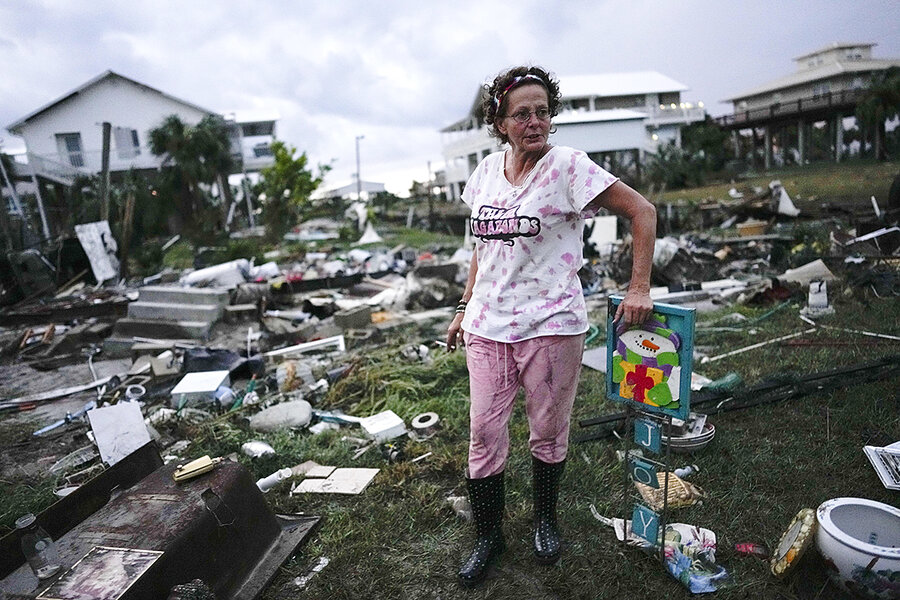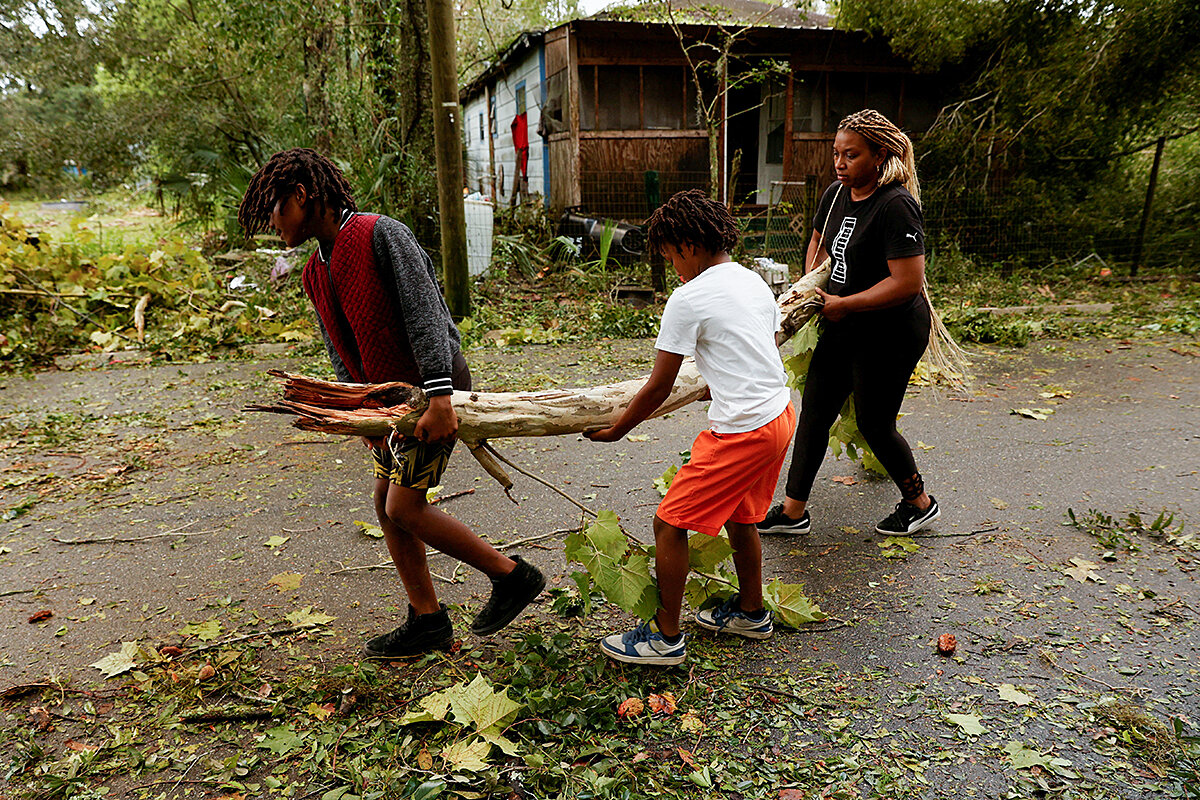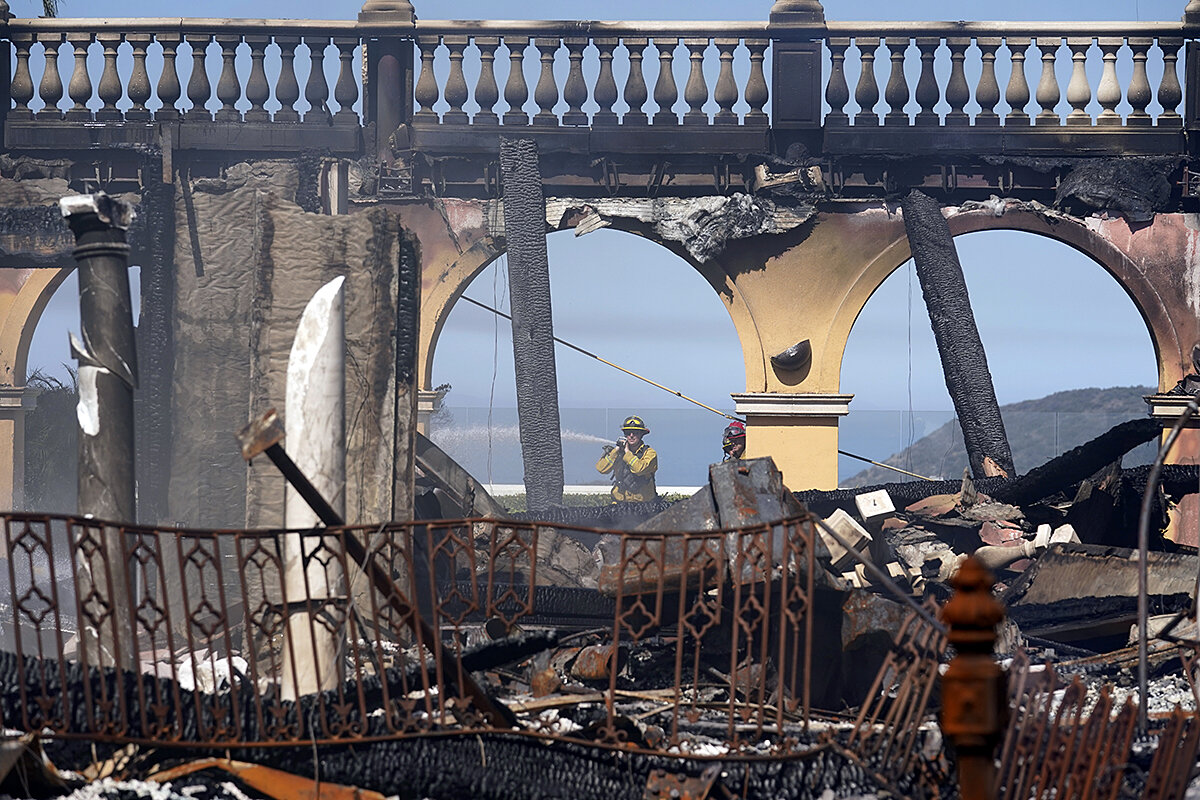From Florida to California, dwindling insurance options
Loading...
| Bakersfield, Calif.
As Hurricane Idalia barreled through Florida Wednesday, thousands of homeowners faced the possibility of rebounding without property insurance.
In the past few years, nearly a dozen property insurers in Florida have liquidated. More have either left the state or restricted coverage, including Farmers Insurance, which pulled out of the Sunshine State last month. Other states prone to high-risk weather events are also losing insurance options. In Louisiana, two dozen insurance companies have dissolved or left since 2020. In California, three of the five largest insurers are limiting new policies or have stopped offering them altogether.
Why We Wrote This
A story focused onAs parts of the United States face extreme weather from hurricanes to wildfires, many of those same places are losing access to home insurance. We explore what’s changing and why.
Insurers say payouts are outpacing revenue, as housing costs rise and climate change contributes to more frequent and costly disasters.
“People are purchasing and moving into much more expensive properties in environmentally sensitive areas,” says Robert Gordon of the American Property Casualty Insurance Association.
Some consumer advocates say insurance companies are creating a crisis narrative to better position themselves.
An insurance crisis is avoidable, says Carmen Balber, executive director of Consumer Watchdog. “We all know that another fire is going to hit, but that’s what the industry is here for. And we need to be investing in the meantime in reducing the risk so we don’t reach the breaking point.”
As Hurricane Idalia barreled through Florida Wednesday, thousands of homeowners faced the possibility of rebounding without property insurance.
In the past few years, nearly a dozen property insurers in Florida have liquidated. More have either left the state or restricted coverage, including Farmers Insurance, which pulled out of the Sunshine State last month. Other states prone to high-risk weather events are also losing insurance options. In Louisiana, two dozen insurance companies have dissolved or left since 2020. In California, three of the five largest insurers are limiting new policies or have stopped offering them altogether.
Insurers say payouts are outpacing revenue, as housing costs rise and climate change contributes to more frequent and costly disasters. But consumer advocates push back and say insurance companies are creating a crisis narrative to better position themselves.
Why We Wrote This
A story focused onAs parts of the United States face extreme weather from hurricanes to wildfires, many of those same places are losing access to home insurance. We explore what’s changing and why.
Insurers are regulated by each state in which they operate, tasking insurance commissioners with balancing the needs of homeowners against the economic viability of covering losses. “There is no quick fix,” writes Michael Soller, spokesperson for California’s insurance commissioner, Ricardo Lara, in an email. He cites “entrenched interests on all sides” and says the system “is clearly not working for all Californians.” Similarly, homeowners across the country face constricting options that are growing more expensive.
Why are insurers leaving high-risk areas?
Climate change plays a significant role, but another key, immediate factor, according to the insurance industry, is the cost of housing. As home prices have lurched upward, other associated costs also increased.
In 2022, insurers paid out about $1.03 in claims for every $1 collected in premiums, according to a report by analytics company Verisk and the American Property Casualty Insurance Association. The industry’s payments and costs increased by 14.1% while premiums grew by 8.3%.
“The boom in home values is really the biggest cost driver impacting insurance rates,” says Robert Gordon, policy and research expert at the association.
Similarly, Verisk sees a mix of factors at play. In a 2022 report, it said insured losses from natural catastrophes during the most recent five years were roughly double those of the half-decade before that. The reasons cited in the report included climate change and shifting regulations, but listed first was “a rise in exposure values and replacement costs, represented both by continued construction in high-hazard areas as well as high levels of inflation that are driving up repair costs.”
“So in other words,” says Mr. Gordon, “it’s just the demographic changes as people are purchasing and moving into much more expensive properties in environmentally sensitive areas.”
But the costs are no justification for abandoning homeowners, says Carmen Balber, executive director of Consumer Watchdog, a consumer advocacy organization based in California. “That’s why Californians have paid $150 billion in home insurance premiums over the last 25 years,” she says. “So the industry would be there when we need them most.”
How does climate change affect home insurance?
Climate scientists say Earth’s warming temperatures are increasing the severity of extreme weather, alongside other factors that have pushed up the cost of natural disasters.
A recent survey by the Insurance Information Institute shows 32% of homeowners have been impacted by weather in the last five years. Weather events – from fire to wind to hail – cause the vast majority of property claims. Yet, insurers have long excluded high-risk events from policies. Congress established the National Flood Insurance Program in 1968 because most insurers excluded flood protection – and still do.
Earthquakes are excluded from standard policies, requiring supplemental coverage. Despite the fact that six of the 10 costliest U.S. earthquakes have happened in California, only 10% of the state’s homeowners carry earthquake coverage.
“Insurance companies would like to only insure the least risky people and leave the more risky people out to the periphery so they can keep only the most profitable policies and leave the ones they might have to pay on to others,” says Ms. Balber.
But the insurance industry doesn’t cause rate changes, says Mr. Gordon, nor does it tell people where to live.
The frequency of climate disasters is compounded by the migration of people moving to areas with the highest risk. National realtor Redfin reports more people are moving into disaster-prone areas than out of them. Eight of the 10 high-flood-risk counties that saw the largest net influx are on the Florida coast. And in Riverside, California, where more homes face wildfire risks than any other county analyzed, nearly 40,000 more people have moved in than out.
The insurance industry offers valuable pricing signals in those areas – like a canary in a coal mine, says Mr. Gordon. “Those nicer homes and the inflation and climate change are making it more expensive to live in environmentally sensitive areas,” he says. “You have to realize that, as people decide where they want to live, the costs and the risks in that are part of those considerations.”
What happens when homeowners lose coverage?
Those homeowners still have access to insurance. Their first step is to shop the remaining companies for a new policy. For consumers who are unable to find or afford a policy, each state offers its own version of a FAIR plan – Fair Access to Insurance Requirements. Some states run those plans themselves; others outsource the plans to private insurers.
FAIR plans have been around since 1968 and offer policies of last resort. They are generally more expensive than regular insurance policies, and coverage tends to target catastrophic events.
Reducing risks before catastrophe strikes helps everyone. Communities can take steps to reduce harm from storms by investing in infrastructure to manage floodwaters or drought. And individuals can do things like home-hardening – using fire-resistant building materials – and clearing flammable debris to drastically reduce fire risks.
About 66% of American households own their home – and 88% of homeowners carry insurance. For those 12% who either can’t afford or choose not to insure their home, fallout can be substantial. “If we can’t insure our home, then we can’t sell our home. It ripples into the real estate market. It ripples into the tourism market,” says Ms. Balber. “So the consequences of that are serious.”
Last year, California became the first state to require insurers to offer discounts to homeowners who make their properties safer from wildfires.
An insurance crisis is avoidable, says Ms. Balber. “We all know that another fire is going to hit, but that’s what the industry is here for. And we need to be investing in the meantime in reducing the risk so we don’t reach the breaking point.”










